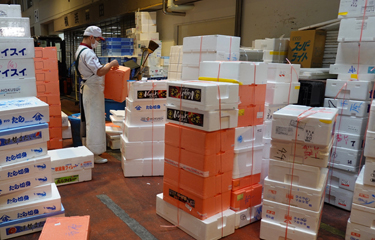Japan’s export push paid off in first half of 2021

Japan’s seafood export strategy is paying off as the world begins to emerge from the COVID-19 pandemic, with its seafood exports up 27 percent in the first half of 2021.
Japan Minister of Minister of Agriculture, Forestry, and Fisheries Kotaro Nogami reported in an online press conference on 3 August that Japan’s exports of agriculture, forestry, and fishery products and foods increased by 31.6 percent in the first half of 2021 from the same period last year to JPY 577.3 billion (USD 5.2 billion, EUR 4.4 billion), the highest ever for the first half of a year.
Nogami said exports of beef and sake, mainly for household use in China and the United States, helped push up the numbers, and that reopening after COVID-19 lockdowns in some areas may have allowed forestry and fishery products to contribute to the growth as well.
Nogami did not provide a breakdown of the figures, but Ministry of Finance trade statistics show exports of fish and fish preparations in the first half of 2019 – before the economic effects of the pandemic – were valued at JPY 115.8 billion (USD 1.05 billion, EUR 0.89 billion). In the coronavirus-affected year of 2020, the value fell by about 18 percent to JPY 95.4 billion (USD 860 million, EUR 740 million). However, in the first half of 2021, the value rose to JPY 121.5 billion (USD 1.1 billion, EUR 930 million), surpassing the pre-COVID level by nearly 5 percent and the H1 2020 level by 27 percent.
Three trading partners – Hong Kong, China, and the U.S.A. – took in nearly 60 percent of Japan’s seafood and fishery product exports in H1. Japan’s main products are scallops, cultured pearls, yellowtail, processed sea cucumber, mackerel, and tuna – including skipjack. These account for about half of all exports in the category. Cultured pearls were about 11.5 percent of the total.
The H1 2021 value for frozen scallops was JPY 79.8 billion (USD 720 million, EUR 610 million), which was an increase of 2.67 times over H1 2020, and 3.6 times that of H1 2019. The suppressed exports last year left a glut of scallops to move out this year at attractive prices, and Japanese domestic consumers have also been enjoying cheaper scallops thus far in 2021. Although growers can choose to leave the scallops to grow another year and market them at a larger size, there is a time limit to this strategy. Japanese scallops are mainly sold to China. While China also produces scallops, the species grown in Japan is larger and so is more suitable for a center-of-plate presentation.
Frozen seriola (yellowtail) export value in H1 2021 totaled JPY 8.4 billion (USD 76 million, EUR 64 million), recovering to 98 percent of the H1 2019 value after a fall in H1 2021 to a level nearly half that of H1 2021. Hong Kong and China were the main importers, with the U.S. not even among the top 20 importers.
Frozen, dried, salted, in brine, or smoked sea cucumbers declined by nearly half from H1 2019 to H1 2020 and stayed at about that level in H1 2021 for a value of JPY 1.2 billion (USD 10.8 million, EUR 9.2 million) which is 4 percent higher than a year earlier but just 52 percent of the value in H1 2019. Sea cucumber is sold to China, where it is thought to have medicinal value as a tonic for the kidneys. It is also a luxury gift item. Japan produces the species Apostichopus japonicus, the species most favored in China. The main production areas are Hokkaido and Aomori.
Frozen mackerel exports were fairly steady. The H1 2021 export value of JPY 1.5 billion (USD 13 million, EUR 11 million) was 13 percent higher than the corresponding period in 2020, and up just 1 percent from that of 2019. The main markets for mackerel have traditionally been China, South Korea, and Thailand, but African countries – notably Nigeria, Egypt, and Ghana – have been taking large volumes of smaller-sized mackerel in recent years. In H1 2021, Vietnam and Egypt were the main importers. At the same time, Japan imports premium large fatty mackerel from Norway.
For Pacific bluefin tuna, Japan exports more in the fresh/chilled form. Volumes in the second half of the year, especially heading into the New Year, are higher than in the first half. Its H1 2021 export value was JPY 95 million (USD 850,000, EUR 730,000), a 92 percent increase over H1 2020. The latest figure was 15 percent higher than the value prior to the pandemic effects in H1 2019 and thus represents a recovery. China was by far the largest market, with Hong Kong, Thailand, the U.S., and Russia following.
Shipments of this item to the United States were valued at JPY 8.3 million (USD 75,000, EUR 64,000) in H1 2021, just 22 percent of the H1 2020 value and 23 percent of the H1 2019 value. Restaurant closure orders in the U.S. began in California in May of 2020 and have been applied sporadically around the country since then.
It is notable that the U.S. share of Japan’s overall seafood exports is fairly negligible as compared with China, Hong Kong, and Southeast Asian destinations. Though still minor, the United Arab Emirates has surprisingly significant imports of sushi items despite its small population, reflecting its wealth and appetite for luxury foods and its role as a hub of transport, distribution, and tourism in the Middle East.
Photo courtesy of HAPIN/Shutterstock






Share